Philips IntelliVue MP40, IntelliVue MP50 Service manual

IntelliVue MP40/50
Service Guide
IntelliVue Patient Monitor
MP40/50
Patient Monitoring

Part Number M8000-9361E 451261018641
*M8000-9361E*

Table of Contents
1 Introduction |
13 |
Who Should Use This Guide |
13 |
How to Use This Guide |
13 |
Abbreviations |
13 |
Responsibility of the Manufacturer |
14 |
Passwords |
14 |
Warnings and Cautions |
14 |
2 Theory of Operation |
17 |
|
|
Monitor Theory of Operation |
17 |
System Boundaries |
17 |
Hardware Building Blocks |
19 |
IntelliVue MP40 |
19 |
IntelliVue MP50 |
20 |
Optional Hardware |
21 |
Compatible Devices |
22 |
Power Supply |
25 |
CPU Boards |
25 |
System Interface and I/O Boards |
26 |
Data Flow |
27 |
Data Acquisition |
27 |
Data Provider System Service |
27 |
Persistent Data Storage System Service |
28 |
Display and User Interface Service |
28 |
Data Output |
28 |
Monitor Applications |
28 |
Internal LAN (Measurement Server Link) |
28 |
Philips Clinical Network |
29 |
How does the Support Tool Work with the Monitor |
30 |
Monitor Software Block Diagram |
30 |
Block Diagram Legend |
32 |
3 Testing and Maintenance |
37 |
|
|
Concepts |
37 |
Test Reporting |
37 |
Frequency |
38 |
Tests When Performing... |
39 |
Installation |
39 |
Repair |
39 |
3

Preventive Maintenance |
39 |
Performance Verification |
40 |
Upgrades |
40 |
Preventive Maintenance Procedures |
40 |
NBP PerformanceTests |
40 |
NBP Accuracy Test |
41 |
NBP Leakage Test |
42 |
NBP Linearity Test |
42 |
Valve Test |
42 |
Microstream CO2 Performance Test |
43 |
Barometric Pressure Check and Calibration |
43 |
Leakage Check |
44 |
Pump Check |
45 |
Flow Rate Check and Calibration |
45 |
Noise Check |
45 |
CO2 Gas Measurement Calibration Check |
45 |
Calibration Verification |
46 |
Reset Time Counters |
46 |
CO2Pump / CO2 Scrubber Replacement |
47 |
Tests |
47 |
Visual Test |
48 |
Power On Test |
48 |
Temperature Performance Test |
48 |
ECG/Resp Performance Test |
48 |
ECG Performance |
48 |
Respiration Performance |
48 |
Invasive Pressure Performance Test |
49 |
SpO2 Performance Test |
49 |
Measurement Validation |
49 |
M3014A Capnography Extension Performance Tests |
49 |
Mainstream CO2 Accuracy Check |
49 |
Sidestream CO2 Accuracy Check |
50 |
Sidestream CO2 Flow Check |
51 |
Spirometry Performance Tests |
51 |
Equipment Required |
51 |
Flow Test |
51 |
Leakage Test |
51 |
Barometer Check |
52 |
Cardiac Output Performance Test |
52 |
Service Tool Procedure, Version 1 |
52 |
Service Tool Procedure, Version 2 |
52 |
BIS Performance Test |
53 |
PIC/DSC Test |
53 |
Nurse Call Relay Performance Test |
53 |
Phone Jack Type Connector Test (Traditional Nurse Call) |
53 |
Multi-Port Nurse Call Connector Test (Flexible Nurse Call) |
54 |
4

ECG Sync Performance Test |
55 |
|
Docking Station Performance Test |
55 |
|
Vuelink Performance Test |
56 |
|
IIT Communication Test |
56 |
|
IntelliVue 802.11 Bedside Adapter Communication Test |
58 |
|
Safety Testing |
58 |
|
Warnings, Cautions, and Safety Precautions |
58 |
|
Safety Test Procedures |
59 |
|
Battery Handling, Maintenance and Good Practices |
62 |
|
About the Battery |
62 |
|
Checking the Battery Status |
62 |
|
Battery Status on the Main Screen |
64 |
|
Battery Status Window |
66 |
|
Viewing Individual Battery Status |
66 |
|
Documenting Battery Status |
67 |
|
Battery Implications |
67 |
|
Conditioning a Battery |
67 |
|
What is Battery Conditioning? |
67 |
|
Why is Battery Conditioning Necessary? |
67 |
|
When Should Battery Conditioning be Performed? |
67 |
|
What Causes the Conditioning Message on the Monitor? |
68 |
|
Conditioning Batteries |
68 |
|
Battery Conditioning in the Monitor |
68 |
|
Battery Conditioning with an External Charger |
69 |
|
Touchscreen Calibration |
69 |
|
Disabling/Enabling Touch Operation |
71 |
|
Printer Test Report |
71 |
|
4 Troubleshooting |
73 |
|
|
|
|
Introduction |
73 |
|
How To Use This Section |
73 |
|
Who Should Perform Repairs |
73 |
|
Replacement Level Supported |
73 |
|
Software Revision Check |
74 |
|
Software Compatibility Matrix |
74 |
|
Obtaining Replacement Parts |
75 |
|
Troubleshooting Guide |
75 |
|
Checks for Obvious Problems |
75 |
|
Checks Before Opening the Instrument |
75 |
|
Checks with the Instrument switched Off |
76 |
|
Checks with the Instrument Switched On, AC connected, without battery |
76 |
|
Checks with the Instrument switched On, AC connected, with battery |
76 |
|
Checks with the Instrument switched On, AC not connected, with battery |
76 |
|
Initial Instrument Boot Phase |
77 |
|
Troubleshooting Tables |
79 |
|
How to use the Troubleshooting tables |
79 |
|
5

Boot Phase Failures |
80 |
Integrated Display is blank |
82 |
Integrated Touch Display not functioning |
82 |
External Display is blank (Slave Display) |
83 |
External Touch Display not functioning |
84 |
General Monitor INOP Messages |
84 |
Remote Alarm Device |
85 |
Remote Extension Device |
86 |
Navigation Point |
86 |
Keyboard/Mouse not functioning |
87 |
Battery related problems |
87 |
Bedside Network Status Icons |
89 |
Network related problems |
89 |
Wireless Ethernet Adapter (Proxim) |
90 |
IIT-related Problems |
91 |
IntelliVue 802.11 Bedside Adapter Problems |
92 |
Multi-Measurement Server |
93 |
MSL-related problems |
93 |
Alarm Issues |
95 |
Alarm Lamps |
95 |
Alarm Tones |
95 |
Alarm Behavior |
96 |
Individual Parameter INOPS |
96 |
Integrated 4-Slot Rack |
97 |
Printer |
97 |
Recorder |
98 |
MIB / RS232 |
99 |
Flexible Nurse Call Relay |
100 |
Basic Nurse Call Relay |
100 |
Troubleshooting the ECG OUT/Alarm LED |
100 |
Docking Station Problems |
101 |
Data Flow Marker In and ECG Wave |
102 |
Status Log |
103 |
List of Error Codes |
104 |
Troubleshooting with the Support Tool |
105 |
Troubleshooting the Individual Measurements or Applications |
105 |
5 Repair and Disassembly |
107 |
|
|
Tools Required |
107 |
Removing the I/O Boards |
108 |
Removing the Interface Board |
110 |
Separating the Front and Back Half of the monitor |
111 |
Exchanging the Backlight Tubes |
113 |
Removing the Flex Panel Adapter |
115 |
Removing the Touchscreen |
118 |
Removing the Flat Panel |
121 |
6

Removing the Backlight Inverter Board |
124 |
Removing the Silicon Mat for the Power Switch and the LEDs |
125 |
Removing the Navigation Point Assembly |
126 |
Removing the ECG Out/Alarm LED Board |
128 |
Removing the Handle |
129 |
Removing the Main Board |
131 |
Removing the MSL Board |
134 |
Removing the Internal Module Rack |
135 |
Removing the Power Supply Assembly |
135 |
Reassembling the Power Supply Assembly |
137 |
Removing the Loudspeaker |
141 |
Changing the Serial Number Plate |
143 |
Exchanging the battery door |
144 |
Plug-in Modules |
146 |
Plug-In Module Disassembly |
146 |
tcpO2/tcpCO2 Calibration Chamber Kit |
147 |
Recorder Module Paper |
148 |
Multi-Measurement Server (MMS) Disassembly |
149 |
Tools required |
149 |
Removing the Front Cover |
149 |
Removing the Mounting Pin |
150 |
Removing the Top Cover |
151 |
Removing the DC/DC Board |
151 |
Removing the MSL Flex Assembly |
152 |
Reassembling the MSL Flex Assembly |
153 |
Refitting the DC/DC board |
154 |
Refitting the Cover |
155 |
Refitting the Front Cover |
156 |
Final Inspection |
156 |
Testing |
157 |
Measurement Server Extensions - Exchanging the Top Cover and the Dual Link Bar157
Exchange Procedures |
157 |
Removing the Front Cover |
158 |
Removing the Mounting Pin |
158 |
Removing the Dual Link Bar |
160 |
Removing the Top Cover |
163 |
Refitting the Top Cover |
163 |
Assembling the dual Link Bar |
164 |
Refitting the Front Cover |
167 |
Final Inspection |
168 |
Testing |
168 |
Disassembly Procedures for the M3015A Measurement Server Extension (HW Rev. A)
168
Removing the Front Cover |
168 |
Removing the Extension Bottom Cover |
169 |
Removing the CO2 Scrubber |
170 |
7

Removing the Pump |
171 |
|
Refit Procedures for the Measurement Server Extension |
171 |
|
Refitting the CO2 Scrubber |
172 |
|
Refitting the Pump |
172 |
|
Refitting the Extension Bottom Cover |
172 |
|
Refitting the Front Cover |
173 |
|
General Reassembly/Refitting Comments |
173 |
|
Following Reassembly |
173 |
|
Smart Battery Charger LG1480 (M8043A) |
174 |
|
Cleaning the Air Filter Mats |
174 |
|
Replacing the Fan |
175 |
|
IntelliVue Instrument Telemetry (IIT) |
177 |
|
Exchanging the PCA board or the Flex Cable |
177 |
|
Exchanging the IIT Module |
178 |
|
Docking Station |
179 |
|
Exchanging the Main Board |
180 |
|
Exchanging the Flex Cable |
183 |
|
6 Parts |
187 |
|
|
|
|
MP40/MP50 Parts |
188 |
|
Multi-Measurement Server Parts |
191 |
|
MMS Part Number Overview and Identification |
191 |
|
MMS Part Numbers - Front Bezel for M3001 #A01 & #A03 |
193 |
|
MMS Part Numbers - Front Bezel for M3001 #A02 |
194 |
|
MMS Part Numbers - Top Cover and MSL Assembly |
195 |
|
MMS Exchange Part Numbers |
196 |
|
M3001A #A01 Philips FAST SpO2 MMS Exchange Numbers |
196 |
|
M3001A #A02 Nellcor OxiMAX-compatible MMS Exchange Numbers |
197 |
|
M3001A #A03 MMS with Masimo SET SpO2 - Exchange Numbers |
197 |
|
MMS Part Numbers - Label Kits |
197 |
|
Measurement Server Extension Parts (M3012A, M3014A, M3015A and M3016A)197 |
||
MMS Extension Part Numbers - Release Mechanisms |
198 |
|
MMS Extension Part Numbers - Top Cover and Link Bar |
198 |
|
MMS Extension Part Numbers - Front Bezels |
198 |
|
Exchange Parts List |
205 |
|
Plug-in Modules Part Numbers |
207 |
|
Part Number Table |
207 |
|
Exchange Modules, Table 1 |
207 |
|
Exchange Modules, Table 2 |
208 |
|
Plug-In Modules Replaceable Parts |
211 |
|
Single-Width Plug-In Module |
211 |
|
Double-Width Plug-In Module |
211 |
|
Plug-in Module Replaceable Parts |
212 |
|
Plug-In Module Language Specific Front Housing Kits (incl. Silicone Buttons, Frames & Bezels), |
||
Table 1 |
212 |
|
Plug-In Module Language Specific Front Housing Kits (incl. Silicone Buttons, Frames & Bezels),
8

Table 2 |
213 |
Plug-In Module Specific Bezels |
214 |
BIS Solution Replaceable Parts |
214 |
BIS Solution Components |
215 |
BISx Solution Replacable Parts |
215 |
BISx Solution Components |
216 |
tcpO2/tcpCO2 Module Accessories |
216 |
Smart Battery Charger Part Numbers |
217 |
IntelliVue Instrument Telemetry Part Numbers |
218 |
IntelliVue 802.11 Bedside Adapter Part Numbers* |
219 |
Docking Station Part Numbers |
219 |
External Display Part Numbers |
220 |
Remote Alarm Device Part Numbers |
222 |
Remote Extension Device Part Numbers |
223 |
7 Installation Instructions |
225 |
|
|
Unpacking the Equipment |
225 |
Initial Inspection |
226 |
Mechanical Inspection |
226 |
Electrical Inspection |
226 |
Claims For Damage and Repackaging |
226 |
Claims for Damage |
226 |
Repackaging for Shipment or Storage |
226 |
Installing the Monitor (M8003A or M8004A) |
226 |
Mounting Instructions |
227 |
Assembling Mounts |
227 |
Connections |
227 |
Installing Interface Boards |
229 |
Connection of Devices via the MIB/RS232 Interface |
231 |
Installing the Docking Station |
231 |
Installing Remote Devices |
232 |
Mounting the 15” Remote Display (M8031A) |
232 |
Connections |
232 |
Mounting the 15” Remote Display (M8031B) |
232 |
Connections |
233 |
Mounting the 17” Remote Display (M8033A/B/C) |
233 |
Connections |
233 |
Video Cable Wiring Schematics |
235 |
Multi-Measurement Server |
235 |
Attaching the MMS to a Mount |
235 |
Detaching the Measurement Server from a Mount |
236 |
Positioning the Measurement Server on a Clamp Mount |
236 |
Mounting the BIS Engine to the Monitor |
237 |
Mounting the Wireless Ethernet Adapter to the Monitor |
238 |
Connections |
241 |
MSL Cable Termination |
241 |
9

PS/2 Keyboard/Mouse243
Philips Clinical Network (Wired)244
Philips Clinical Network (Wireless)244
Nurse Call Relay244
Connections244
ECG Out Functionality245
Connections245
Configuration Tasks245
Setting Altitude and Line Frequency246
Configuring the Equipment Label246
Configuring the printer246
8 Site Preparation |
247 |
Introduction247
Site Planning247
Roles & Responsibilities247
Site Preparation Responsibilities247
Procedures for Local Staff248
Procedures for Philips Personnel249
Monitor M8003A and M8004A Site Requirements249
Space Requirements249
Environmental Requirements249
Temperature249
Humidity249
Altitude250
Battery Storage250
Electrical and Safety Requirements (Customer or Philips)250
Safety Requirements250
Electrical Requirements250
Remote Device Site Requirements250
Connecting Non-Medical Devices251
Multi-Measurement Server M3001A 252
Space Requirements Multi-Measurement Server M3001A252
Environmental Requirements Multi-Measurement Server M3001A252
Cabling Options and Conduit Size Requirements252
Mounting253
Remote Displays (M8031A)253
Space Requirements253
Environmental Requirements254
Electrical and Safety Requirements254
Remote Displays (M8031B)254
Space Requirements254
Environmental Requirements254
Electrical and Safety Requirements255
Remote Displays - M8033A255
10

Space Requirements255
Environmental Requirements255
Electrical and Safety Requirements255
Remote Displays - M8033B255
Space Requirements255
Environmental Requirements256
Electrical and Safety Requirements256
Remote Displays - M8033C256
Space Requirements256
Environmental Requirements256
Electrical and Safety Requirements257
Cabling Options and Conduit Size Requirements257
Touch Cable258
Remote Alarm Devices258
Space Requirements258
Mounting258
Cabling Options and Conduit Size Requirements258
Remote Extension Device259
Space Requirements259
Mounting259
Cabling Options and Conduit Size Requirements259
Input Devices260
Local Printer260
Philips Medical LAN261
RS232/MIB/LAN Interface261
Nurse Call Relay Interface262
ECG Out Interface262
9 |
Gas Analyzers |
263 |
A |
Philips 15210B Calibration Unit |
265 |
Unpacking the Instrument265
Initial Inspection265
Claims for Damage266
Repacking for Shipment or Storage266
Instrument Identification266
Specification266
Operating Environment266
Operating Information266
Fitting the Gas Cylinders267
Storage of Gas Cylinders267
Disposal of Used Gas Cylinders267
Routine Maintenance267
Changing the Gas Cylinders267
Care and Cleaning267
Theory of Operation268
11

Gas Flow Performance Check268
Test Procedure268
Action if outside specification269
Disassembly270
Parts List272
B IntelliVue Product Structure |
273 |
Upgrade Options274
12

1
Introduction
This Service Guide contains technical details for the IntelliVue MP40 and MP50 Patient Monitor, the measurement modules, the Multi-Measurement Server (MMS), and the Measurement Server Extensions.
This guide provides a technical foundation to support effective troubleshooting and repair. It is not a comprehensive, in-depth explanation of the product architecture or technical implementation. It offers enough information on the functions and operations of the monitoring systems so that engineers who repair them are better able to understand how they work.
It covers the physiological measurements that the products provide, the Measurement Server that acquires those measurements, and the monitoring system that displays them.
Who Should Use This Guide
This guide is for biomedical engineers or technicians responsible for troubleshooting, repairing, and maintaining Philips’ patient monitoring systems.
How to Use This Guide
This guide is divided into eight sections. Navigate through the table of contents at the left of the screen to select the desired topic. Links to other relevant sections are also provided within the individual topics. In addition, scrolling through the topics with the page up and page down keys is also possible.
Abbreviations
Abbreviations used throughout this guide are: |
|
Name |
Abbreviation |
IntelliVue MP40/MP50 Patient Monitor |
the monitor |
Multi-Measurement Server |
MMS |
Measurement Server Link |
MSL |
Medical Information Bus |
MIB |
Anesthetic Gas Module |
AGM |
13

1 Introduction |
Responsibility of the Manufacturer |
Responsibility of the Manufacturer
Philips only considers itself responsible for any effects on safety, EMC, reliability and performance of the equipment if:
•assembly operations, extensions, re-adjustments, modifications or repairs are carried out by persons authorized by Philips, and
•the electrical installation of the relevant room complies with national standards, and
•the instrument is used in accordance with the instructions for use.
To ensure safety and EMC, use only those Philips parts and accessories specified for use with the monitor. If non-Philips parts are used, Philips is not liable for any damage that these parts may cause to the equipment.
This document contains proprietary information which is protected by copyright. All Rights Reserved. Reproduction, adaptation, or translation without prior written permission is prohibited, except as allowed under the copyright laws.
Philips Medizin Systeme Böblingen GmbH
Hewlett-Packard Str. 2
71034 Böblingen, Germany
The information contained in this document is subject to change without notice.
Philips makes no warranty of any kind with regard to this material, including, but not limited to, the implied warranties or merchantability and fitness for a particular purpose.
Philips shall not be liable for errors contained herein or for incidental or consequential damages in connection with the furnishing, performance, or use of this material.
Passwords
In order to access different modes within the monitor a password may be required. The passwords are listed below.
Monitoring Mode: No password required
Configuration Mode: 71034
Demo Mode: 14432
Service Mode: 1345
Consult the configuration guide before making any changes to the monitor configuration.
Warnings and Cautions
In this guide:
•A warning alerts you to a potential serious outcome, adverse event or safety hazard. Failure to observe a warning may result in death or serious injury to the user or patient.
•A caution alerts you where special care is necessary for the safe and effective use of the product. Failure to observe a caution may result in minor or moderate personal injury or damage to the product or other property, and possibly in a remote risk of more serious injury.
14

Warnings and Cautions |
1 Introduction |
NOTE When an IntelliVue MP40/MP50, software revision B.0 with battery option installed is used together with an IntelliVue Infromation center D.01 or E.0 and the monitor issues battery-related INOPs, these INOPS are displayed as “UNKNOWN” on the IntelliVue Information Center. Upgrade the Information Center text catalog to E.01 if using an MP40/MP50 monitor with the Information Center.
15

1 Introduction |
Warnings and Cautions |
16

2
Theory of Operation
Monitor Theory of Operation
The IntelliVue MP40/MP50 Patient Monitor:
•displays real-time data
•controls the attached measurement server
•alarms in the case of patient or equipment problems
•offers limited data storage and retrieval (trending)
•interfaces to the Philips Clinical Network and other equipment
A monitor with just a single integrated measurement server can be connected to additional building blocks to form a monitoring system with a large number of measurements, additional interface capabilities and one slave display. These elements cooperate as one single integrated real-time measurement system.
System Boundaries
The following diagram discusses specific boundaries within the overall system with respect to their openness and real-time requirements:
17
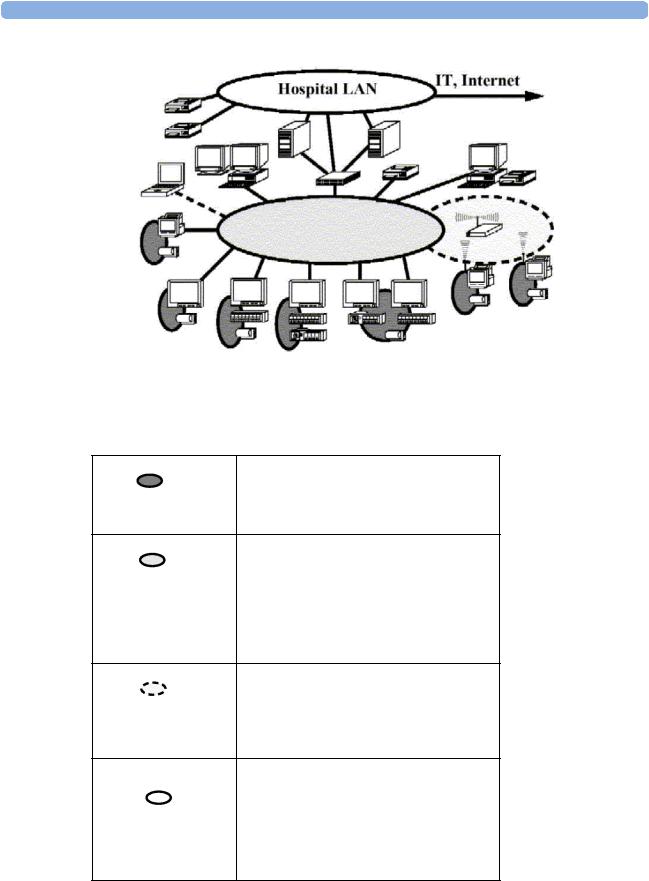
2 Theory of Operation |
Monitor Theory of Operation |
Philips Clinical Network
Measurement LAN
combines components of one patient monitor; real time requirements across all interconnected elements
Philips Clinical Network (wired LAN)
connects multiple patient monitors, information centers, application servers; closed system, only Philips qualified products (tested and with regulatory approval) are connected, Philips is responsible for guaranteed real-time functionality and performance
Philips Clinical Network (wireless)
like Philips Clinical Network (wired) LAN, however due to current wireless technologies available it has reduced bandwidth, longer latencies, reduced functionality
Hospital LAN, Internet
Standard Network, not under Philips control, no guaranteed service, no real-time requirements
18
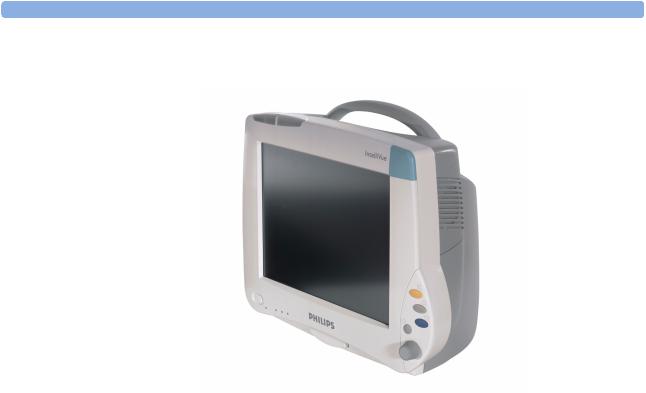
Monitor Theory of Operation |
2 Theory of Operation |
Hardware Building Blocks
The following hardware building blocks make up the monitoring system:
IntelliVue MP40
The MP40 monitor:
•integrates the display and processing unit into a single package
•uses a 12.1” TFT SVGA color display
•uses the Philips Navigation Point as primary input device; computer devices such as mice, trackball, and keyboard can be added optionally
•has an optional 4-slot rack
•supports the MMS and MMS extensions.
19
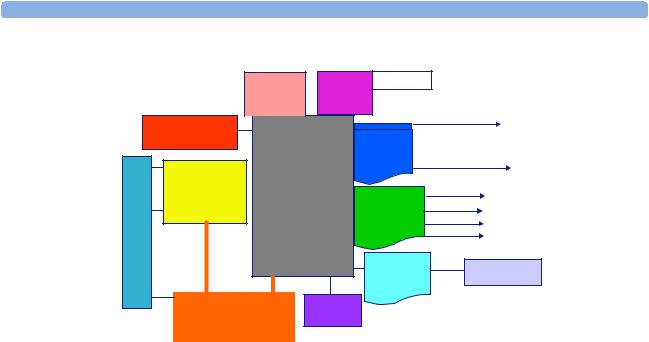
2 Theory of Operation |
Monitor Theory of Operation |
Building Blocks: |
|
|
|
|
|
|
|
Ba ttery |
Rack |
4 Modules |
|
|
|
|
|
||
|
|
Boa rd |
Board |
Dual MIB/ RS232 Interface |
|
|
|
|
|
|
|
Power Supply |
|
|
I/O |
Parallel Printer Interface |
|
|
|
|
|
Flexible Nurse Call Relay I/F |
|
Backlig |
Assembly |
Main Board |
Boa rd Dual PS2 Interface |
||
S ystem |
LAN (wireless) |
||||
|
LCD |
|
|
|
Remote Device Interface |
|
|
|
|
|
|
ht |
|
|
Interface |
LAN (wired) |
|
|
|
|
Boa rd |
Bas. Alarm Relays |
|
.Inv |
|
|
|
||
|
|
|
|
Slave Video out |
|
Boa |
|
|
|
MSL |
Docking interface |
|
|
|
MMS CPU |
||
|
|
|
|
||
|
|
|
|
I/F |
|
rd |
|
|
|
|
|
P a nel Ada pter |
|
|
|
||
|
ECG Out |
|
|
||
|
F lex |
|
|
|
|
IntelliVue MP50
The MP50 monitor:
•integrates the display and processing unit into a single package
•uses a 12.1” TFT XGA color display
•uses the Philips Touchscreen and Philips Navigation Point as primary input devices. Computer devices such as mice, trackball, and keyboard can be added optionally.
•has an optional 4-slot module rack
•supports the MMS and MMS extensions
20

Monitor Theory of Operation |
|
|
|
|
|
|
|
|
|
|
|
|||||
Building Blocks: |
|
|
|
|
|
|
|
|
|
|
|
|||||
|
|
|
|
|
|
|
|
|
|
|
|
|
Rack |
|||
|
|
|
|
|
|
|
|
|
|
Battery |
|
|
||||
|
|
|
|
|
|
|
|
|
|
Boa rd |
|
|
Board |
|||
|
|
|
Power Supply |
|
|
|
|
|
|
|
||||||
|
|
|
|
|
|
|
|
|
|
|
|
|
|
|
|
|
|
|
|
|
|
|
|
|
|
|
|
|
|
|
|
|
|
|
|
|
LCD |
|
|
Touch |
|
Main Board |
||||||||
|
|
Assembly |
|
|
Panel |
|
||||||||||
|
|
|
|
|
|
|
|
|
|
|
|
|
|
|
|
|
|
|
|
|
|
|
|
|
|
|
|
|
|
|
|||
|
htckligBa Board.Inv |
|
|
|
|
|
|
|
|
|
|
|
|
|||
|
|
Touch |
|
|
|
|
|
|
||||||||
|
|
|
|
|
|
|
|
|
|
|
|
|
|
|||
|
|
|
|
|
|
Controller |
|
|
|
|
|
|
||||
|
|
|
|
|
|
|
|
|
|
|
|
|
|
|
|
|
|
|
|
|
|
|
|
|
|
|
|
ECG Out |
|||||
|
|
|
|
|
P a nel Ada pter |
|
||||||||||
|
|
|
|
|
|
|||||||||||
|
|
|
|
|
|
|
|
F lex |
|
|
|
|||||
|
|
|
|
|
|
|
|
|
|
|
|
|
|
|
|
|
2 Theory of Operation
4 Modules
Dual MIB/ RS232 Interface Parallel Printer Interface
I/O Flexible Nurse Call Relay I/F Boa rd Dual PS2 Interface
Remote Device Interface
S ystem |
|
|
LAN (wireless) |
||
|
|
||||
Interface |
|
LAN (wired) |
|||
Boa rd |
|
|
Bas. Alarm Relays |
||
|
|
|
|
Slave Video out |
|
MSL |
|
Docking interface |
|||
MMS CPU |
|
||||
I/F |
|
||||
|
|
|
|||
|
|
|
|||
Optional Hardware
An integrated 4-Slot module rack and a battery board can be ordered optionally. One slot is provided for one of two available system interface boards. If the monitor is ordered with the wireless LAN option a wireless transmitter is required. For further details regarding the wireless network please refer to the M3185A Philips Clinical Network documentation.
 MMSMMServerMount Mount
MMSMMServerMount Mount
 4-S lot Ra ck
4-S lot Ra ck
Ba ttery
Compa rtment
P owersupply |
P owerplug |
|
Heatsink |
||
|
Figure 1 MP40/50 Rear
21
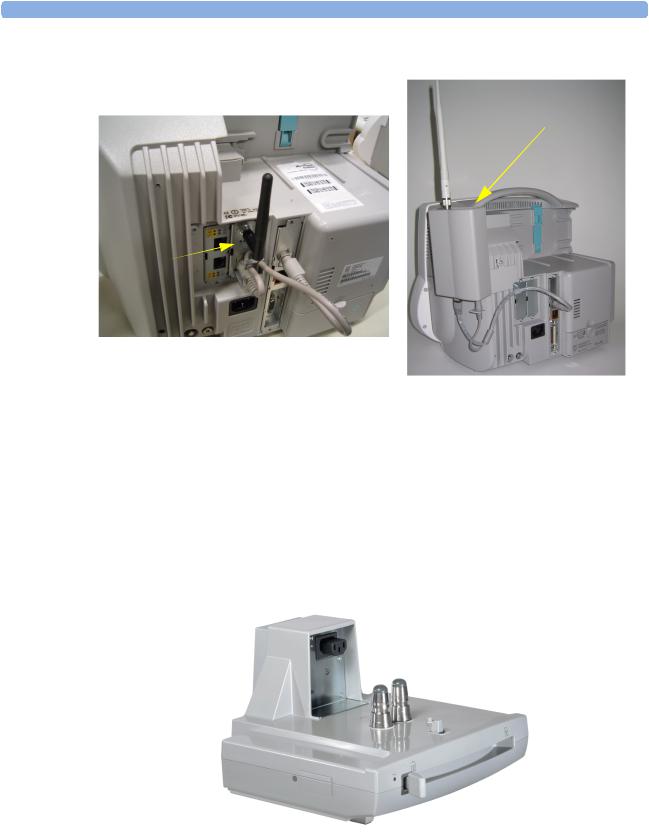
2 Theory of Operation |
Monitor Theory of Operation |
IIT Adapter
IntelliVue 802.11
Bedside Adapter
Figure 2 MP40/50 Rear with internal IntelliVue 802.11 Bedside Adapter (left) and with external IIT Adapter (US only) (right)
NOTE The IntelliVue 802.11 Bedside Adapter and the IIT Adapter require a monitor with Software Rel. C.0 or higher.
Compatible Devices
Figure 3 M8045A Docking Station
22

Monitor Theory of Operation |
2 Theory of Operation |
Figure 4 M3001A Multi-Measurement Server (MMS)
Figure 5 M3012A, M3014A, M3015A, M3016A MMS Extensions
23
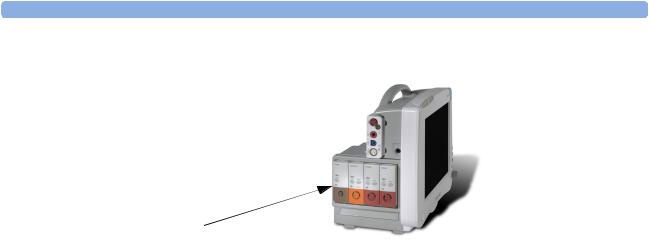
2 Theory of Operation |
Monitor Theory of Operation |
Figure 6 Parameter Modules
List of supported modules:
•M1006B Invasive Blood Pressure Module
•M1029A Temperature Module
•M1012A Cardiac Output / Continuous Cardiac Output Module
•M1018A Transcutaneous Gas Module
•M1020B SpO2 Module
•M1027A EEG Module
•M1034A BIS Module
•M1116B Thermal Array Recorder Module
•M1032A VueLink Device Interface Module
24
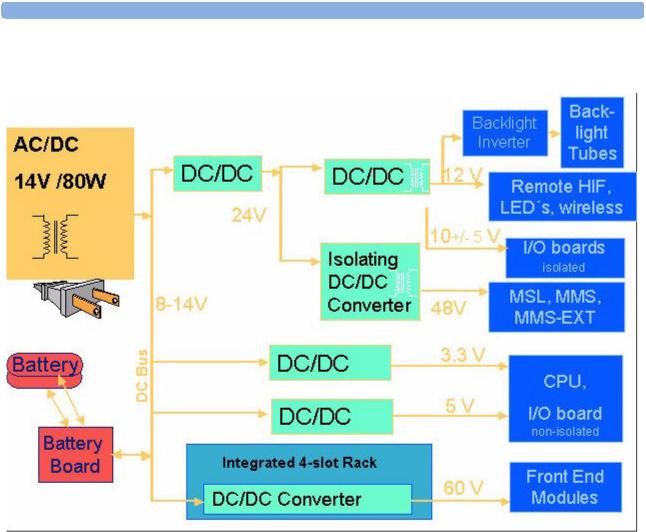
Monitor Theory of Operation |
2 Theory of Operation |
Power Supply
Figure 7 Power Supply Architecture
The AC/DC converter transforms the AC power coming from the power plug into 14 V/80W DC source and isolates the monitoring system from the AC power mains.The 14V is distributed via power bus and supplies power to all the components of the system: The 48V DC power needed for the MMS and measurement server extension is created by an isolating DC/DC converter. The power needed for the backlights is converted to 12V DC by the backlight DC/DC converter. The CPU and the nonisolated I/O boards are supplied with 3.3 V and 5 V DC power. Isolated interface boards require a power of 10V AC. The remote HIF board and the LEDs are supplied with 12V DC power.
CPU Boards
The CPU boards have an MPC852/50 MHz processor in the patient monitor and an MPC860/ 50MHz in the MMS that provides a number of on-chip, configurable interfaces. An array of fast UARTS with configurable protocol options are implemented in an ASIC (along with other system functions such as independent watchdogs etc.), providing interfacing capabilities to measurement modules and System Interface and I/O boards. The serial interfaces can easily be electrically isolated. The main board contains additional video hardware.
25
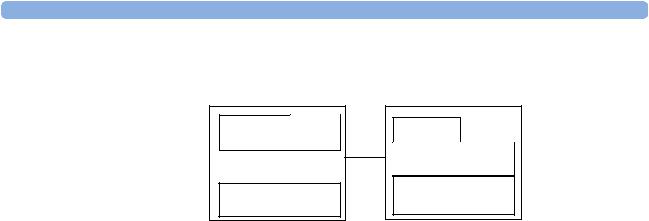
2 Theory of Operation |
Monitor Theory of Operation |
IntelliVue Patient Monitor |
Multi-Measurement Server |
CPU Video
Bank of I/Os
Interfaces
CPU
Bank of I/Os
Measurement
Acquisition
The CPUs provide two LAN interfaces to interconnect CPUs (via the MSL) and to connect to the Philips Clinical Network.
The CPU capabilities are identical. Different loading options are coded on serial EEPROMs to support the automatic configuration of the operating system at boot time.
System Interface and I/O Boards
Interfaces to the monitor are implemented via I/O boards. The location of these boards is restricted by general rules. The I/O slot designations diagram and the I/O matrix which outline the I/O board placement rules can be found in the Installation Instructions section.
The following is a list of Interface (I/O) boards which may be present in your monitor, depending on your purchased configuration:
System Interface boards:
•MSL
•Video for slave display
•Philips Clinical Network (LAN wired or wireless)
•Basic Alarm Relay (Nurse Call)
•Docking Interface
I/O boards:
•PS/2
•MIB/RS232
•Flexible Nurse Call
•Parallel printer
•Remote devices (Remote Alarm Device, Remote Extension Device)
•IntelliVue 802.11 Bedside Adapter
The specifications for the above listed interfaces can be found in the technical data sheet for the monitor and in the Installation and Specifications chapter of the Instructions for Use.
26

Monitor Theory of Operation |
2 Theory of Operation |
Data Flow
The following diagram shows how data is passed through the monitoring system. The individual stages of data flow are explained below.
Display
and User
 Interface
Interface
Data |
|
Data |
|
Applications |
Acquisition |
|
Provider |
|
|
|
|
|||
|
|
Service |
|
|
Persistent |
Data |
|
Data |
||
Output |
||
Storage |
||
|
Data Acquisition
Monitoring data (for example patient measurement data in the form of waves, numerics and alerts) is acquired from a variety of sources:
•Measurement Server
The Measurement Server connected to the internal LAN converts patient signals to digital data and applies measurement algorithms to analyze the signals.
•External measurement devices
Data can be also acquired from devices connected to interface boards of the monitor. Software modules dedicated to such specific devices convert the data received from an external device to the format used internally. This applies to parameter modules and the Anesthetic Gas Module.
•Server systems on the Philips Clinical Network
To enable networked applications such as the other bed overview, data can be acquired from server systems attached to the Philips Clinical Network, for example a Philips Information Center
Data Provider System Service
All data that is acquired from measurement servers or external measurement devices is temporarily stored by a dedicated data provider system service. All monitor applications use this central service to access the data in a consistent and synchronized way rather than talking to the interfaces directly.
This service makes the applications independent of the actual type of data acquisition device.
The amount of data stored in the data provider system service varies for the different data types. For example several seconds of wave forms and the full set of current numerical values are temorarily stored in RAM.
27

2 Theory of Operation |
Monitor Theory of Operation |
Persistent Data Storage System Service
Some applications require storage of data over longer periods of time. They can use the persistent data storage system service. Dependent on the application requirements, this service can store data either in battery backed-up (buffered) memory or in flash memory. The buffered memory will lose its contents if the monitor is without power (not connected to mains) for an extended period of time. The flash memory does not lose its contents.
The trend application for example stores vital signs data in a combination of flash memory and buffered memory, while the system configuration information (profiles) is kept purely in flash memory.
Display and User Interface Service
Applications can use high level commands to display monitoring data or status and command windows on the internal LCD panel. These commands are interpreted by the display manager application. This application controls the dedicated video hardware which includes video memory and a special ASIC.
User input is acquired from a variety of input devices, for example the Navigation Point, the touchscreen or other standard input devices (keyboard, mouse) which may be attached to I/O boards. The system software makes sure that the user input is directed to the application which has the operating focus.
Data Output
The monitoring system is very flexible and customizable regarding its data output devices. Built-in devices (for example LAN, alarm lamps, speaker, video) provide the basic output capabilities.
These capabilities can be enhanced by adding additional I/O boards, as required in the specific enduser setup. The additional I/O boards typically provide data to externally attached devices, for example to printers, RS232 based data collection devices, nurse call systems etc.
The monitor can identify I/O boards by means of a serial EEPROM device that stores type and version information. The operating system detects the I/O boards and automatically connects them with the associated (interface driver) application. For some multi-purpose cards it is necessary to configure the card for a particular purpose first (for example the dual MIB/RS232 card can support external touch display (only slave display), data import, data export).
Monitor Applications
The monitor applications provide additional system functionality over the basic measurement and monitoring capabilities. This includes for example trending, report generating, event storage or derived measurements.
In general, the monitor applications use the data provider system service to access the measurement data. Application interfaces to the other system services allow the application to visualize data, to store data over extended periods of time or to output data to other devices.
Internal LAN (Measurement Server Link)
All components of the monitoring system (including measurement servers and CPUs in the monitor) communicate using an IEEE802.3/ Ethernet LAN in the Measurement Server Link (MSL). This network is used to distribute data between the components, for example:
•Digitized patient signals including wave data, numerical data and status information (typically from the measurement server to a display unit)
28
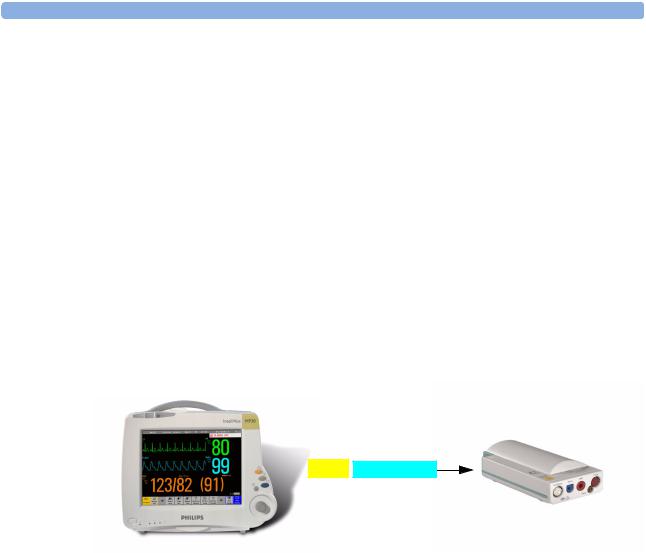
Monitor Theory of Operation |
2 Theory of Operation |
•Control data representing user interactions (typically from the display unit to a measurement server)
•Shared data structures, for example representing patient demographical data and global configuration items
The internal LAN allows plug and play configuration of the monitoring system. The system automatically detects plugging or unplugging of measurement servers and configures the system accordingly.
The components on the internal LAN are time-synchronized to keep signal data consistent in the system. Dedicated hardware support for synchronization eliminates any latency of the network driver software.
The integrated LAN provides deterministic bandwidth allocation/reservation mechanisms so that the real-time characteristic of signal data and control data exchange is guaranteed. This applies to the data flow from the measurement server to the monitor (for example measurement signal data) and the data flow from the monitor to a measurement server (for example to feed data to a recorder module).
Integrated communication hubs in the monitor allow flexible cabling options (star topology, daisy chaining of servers).

 MDSE Internal LAN
MDSE Internal LAN
Philips Clinical Network
The monitoring system may be connected to the Philips Clinical Network, for example to provide central monitoring capabilities or other network services. This connection may be through a normal wired connection or through a wireless connection.
The monitor supports the connection of an external wireless adapter or an internal wireless adapter (#J35). Switching between wired and wireless networks is automatically triggered by the plugging or unplugging of the network cable.
The Philips Clinical Network protocols function very similarly to the protocols used on the internal LAN.
After configuration, the monitoring system sends the digitized patient signals including wave data, numerical data and status information onto the network. Control data representing user interactions can be exchanged between the monitoring system and a central station bi-directionally.
Additional protocols are supported for networked applications, for example for the other bed overview function, which allows viewing of monitoring data from other patients on the network.
29

2 Theory of Operation |
Monitor Theory of Operation |
For plug and play operation, the monitoring system uses the standard BootP protocol to automatically acquire a network address.
How does the Support Tool Work with the Monitor
The support tool is a Windows application typically installed on the laptop of a customer engineer or a biomedical engineer working in the customer’s own service department.
The purpose of the support tool is to upgrade, configure and diagnose all monitoring components (modules, measurement servers, and monitors) in the system over the network.
The service protocol developed for this purpose uses a raw access to the devices without the need for IP addresses etc. over a standard customer network installation, so that even defective devices can be upgraded as long as the few kBytes of initial boot code are working. The boot code itself can also be upgraded using the same protocol.
The tool allows access to internal service information and to serial numbers. It can be remotecontrolled, for example via a dial-up connection from a response center, provided the proper infrastructure is in place.
For details see the Instructions for Use for the Support Tool.
Monitor Software Block Diagram
Figure 8 shows the functional block diagram for the monitoring system. A legend explaining terms and diagram elements follows. The information below varies depending on the purchased monitor options.
30
